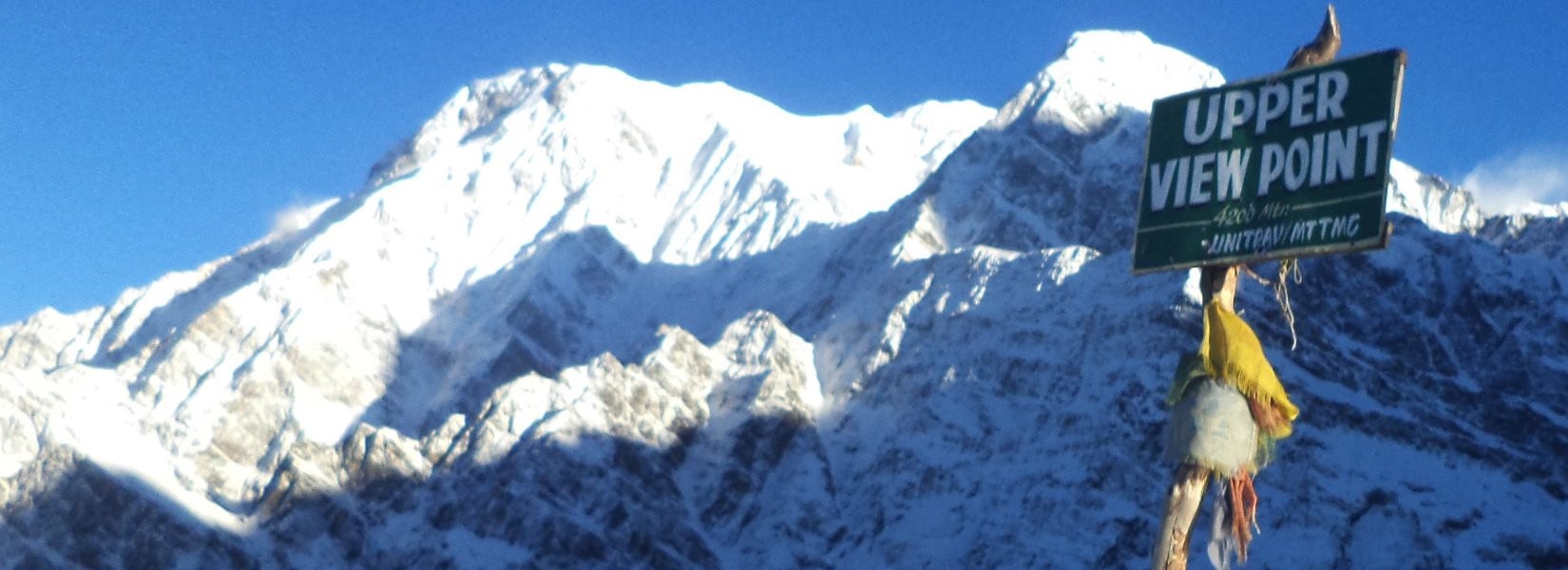Useful Information
Packing the bags alone and moving to the trek alone isn’t enough for you. If you’re planning to go for the exciting Mardi Himal trek, here is some crucial information.
Mardi Himal Trek Difficulty
The Mardi Himal Trek is moderately complex. You do not need any technical climbing skills. However, the steep trails and high altitude can be challenging. Trekkers need to be physically fit and ready to hike for 5–6 hours daily.
The route has both gentle slopes and steep climbs, with the final stretch to the base camp being the hardest. Adjusting to the altitude is important to prevent sickness, so taking it slow and allowing time to acclimate is key.
Best Season for Mardi Himal Journey
The optimal period for trekking on the Mardi Himal is the spring season (March- May) or autumn (September- November). You will see the blue sky and the weather is clear at this time. The mountains look equally beautiful and the temperature gets it’s ideal for hiking. The temperature can range from 18 degrees Celsius (64.4 degrees Fahrenheit) to 21 degrees Celsius (69.8 degrees Fahrenheit) in the daytime.
In the nighttime, you can expect a drop to 5 degrees Celsius (41 degrees Fahrenheit) to 0 degrees Celsius (32 degrees Fahrenheit). Another beauty of visiting in spring is the bright rhododendron blossoms that add beauty to the trails.
(Don’t go in monsoon season, June-August, which is the worst time to go.) Due to the heavy rain, the trails might be muddy and slippery. Also, you might find leeches everywhere, and the thick clouds can block the possible mountain views. It’s better to avoid this season because rain can ruin your whole trek.
Winter (December-February) is the most challenging time. At this time, the trails are icy, and the temperature falls to freezing. However, if you love adventure and can tolerate the cold, the scenery of snow-covered hills awaits you. Though the hike gets challenging, there the equal rewards.
We recommend you to visit in the spring or autumn for your Mardi Himal trek when the trails are safer and the weather favors you.
Food and Accommodation on Mardi Himal Trek
Accommodation
In Pokhara, you will stay in a comfortable hotel. But on the Mardi Himal Trek, you will stay in simple teahouses. These teahouses have basic rooms with a bed and minimal equipment. If you are at lower altitudes, you might get a private bathroom.
At higher altitudes, the accommodation becomes more essential. You will have to share bathrooms. However, teahouses are great places to meet other trekkers and share experiences.
Food
On the trek, you will have breakfast, lunch, and dinner at the teahouse. Breakfast may include toast, porridge, muesli, pancakes, or eggs with tea or coffee. For lunch, you may have dal bhat, noodles, pasta, rice dishes, or sometimes sandwiches.
Dinner usually includes dal bhat, pasta, momos, and curries. You will also find snacks like chocolate, energy bars, and nuts in the teahouses. It’s a good idea to carry extra snacks for the long trekking days.
This simple setup lets you experience the real Himalayan spirit. You’ll enjoy local hospitality and basic but tasty food, making your trek both comfortable and memorable.
Packing List for Mardi Himal Trek
Since the trip is for 5 days long, you’ll need many items throughout the trek. Some of the essential items to carry for the Mardi Himal trek are:
Clothes for Mardi Himal Trek:
• Thermal shirts & trousers: These keep you warm in cold temperatures, especially at night.
• Hiking pants: Comfortable and flexible for long treks.
• Waterproof trousers: Essential for rain and unexpected weather changes.
• T-shirts: Lightweight, moisture-wicking fabric is best.
• Fleece or down jacket: Provides insulation during cold mornings and evenings.
• Wind & waterproof jacket: Protects against strong winds and rain.
• Underwear & sports bras: Quick-drying and breathable material is ideal.
Footwear:
• Hiking boots: Sturdy, waterproof, and well-broken-in to prevent blisters.
• Socks: Woolen or synthetic socks for warmth and comfort.
• Rubber sandals: Useful for resting your feet at teahouses.
Bags:
• Rucksack: 40-50L backpack to carry your essentials.
• Daypack: A smaller bag for water, snacks, and important items.
Accessories:
• Woolen cap or balaclava: Keeps your head and ears warm in high altitudes.
• Gloves: Insulated gloves for warmth and protection.
• Headlamp: A must for early morning hikes or nighttime use.
• Power bank: Keeps your phone and camera charged.
• Water bottles & purification tablets: Make sures safe drinking water throughout the trek.
• Sleeping bag: Rated for temperatures as low as -10°C for cold nights.
• Trekking pole: Reduces strain on knees and improves stability on steep trails.
Personal Care:
• Sunglasses & sun hat: Protects against strong mountain sun.
• Sun cream & lip balm: Prevents sunburn and chapped lips.
• Wet wipes & hand sanitizer: Helps maintain hygiene on the trail.
Miscellaneous:
• Cash: Needed for food, accommodation, and other expenses (ATMs are unavailable).
• Snacks: Energy bars, chocolates, or nuts for quick energy.
• Toilet paper: Essential, as many teahouses don’t provide it.
• First-aid kit: Includes bandages, pain relievers, and altitude sickness medication.
• Wristwatch: Useful for tracking time during the trek.
• Dust mask: Protects from dust on dry trails.
Essential Documents:
• Travel Insurance: Must cover high-altitude trekking and emergency evacuations.
• Passport: Required for permits and identification.
• Nepal Visa: Obtainable on arrival or in advance.
Frequently Asked Questions (FAQs)
What is Mardi Himal famous for?
Mardi Himal is known for its amazing mountain views and peaceful trekking trails. It takes you up to 4,500 meters at Mardi Himal Base Camp, where you can see stunning views of the Annapurna range, Mardi Himal, and Hiunchuli Peaks. It is one of the best short treks in Nepal, offering a mix of adventure and natural beauty.
Can beginners trek to Mardi Himal?
Mardi Himal is a very suitable trekking route for everyone, ranging from beginners to pro-trekkers. It is because of its better organized small tea houses as well as accommodation lodges.
You’ll pass through beautiful Gurung villages and other villages such as Pothana, Dhampus, Kalimati, Siding, and Pritam Deurali.
How difficult is the Mardi Himal trek?
You’ll find the Mardi Himal Trek a moderate trekking trail in terms of difficulty. However, it's also considered a good trek for families in the Annapurna region. The trail goes both uphill and downhill, and the stone steps can be challenging to walk down. It can strain your muscles or hurt your knees, so walk carefully and keep a steady pace.
When is the best time to do Mardi Trekking?
The best time to visit the Mardi Himal Trek is when the weather is clear and the trails are not too crowded. The ideal months are mid-February to early March and mid-September to early October. During these months, you can enjoy stunning mountain views, pleasant temperatures, and a more comfortable trekking experience.
The skies are usually clear, making it perfect for sightseeing and photography. Plus, the trails are less busy, allowing you to enjoy the peaceful beauty of the Himalayas fully.
What are the main highlights of the Mardi Himal Trek?
The main highlights of the Mardi Himal Trek are the stunning views of the Annapurna range, Mardi Himal, and Hiunchuli peaks. The trek offers a quiet and less crowded experience, with beautiful paths through thick rhododendron forests and traditional Gurung and Magar villages. It allows trekkers to enjoy both the natural beauty and cultural heritage of the Annapurna region while keeping the difficulty at a moderate level.
What is the highest elevation of the Mardi Himal Trek?
The highest point on the Mardi Himal Trek is 4,200 meters at the Mardi Himal Base Camp. However, if you decide to go for the Mardi Himal Peak climb, you will reach a maximum altitude of 5,500 meters. Remember to stay hydrated and make sure everyone in your group follows safety precautions at higher altitudes.
Which mountains are seen from the Mardi Himal Base Camp?
From the Mardi Himal Base Camp, you can see the fantastic views of the Annapurna Himalayan range:
• Annapurna I (8,091m)
• Annapurna II (7,937m)
• Annapurna III (7,855m)
• Annapurna IV (7,525m)
• Annapurna South (7,819m)
• Hiunchuli (6,441m)
• Dhaulagiri I & II (8,163m/7,751m)
• Machhapuchhare (6,991m)
• Mardi Himal (5,588m)
• Nilgiri (6,940m)
• Varaha Shikhar (7,847m)
• Thapa Peak (6,015m)
• Tukuche Peak (6,920m)
• Singu Chuli (6,500m)
• Tharpu Chuli (5,663m)
• Gangapurna (7,483m)
• Lamjung Himal (6,931m)
What kind of permits are required for this Mardi Himal Trek?
Yes, you need a permit for the Mardi Himal Trek since it’s part of the Annapurna Conservation Area. You can get the ACAP permit in Kathmandu or Pokhara. This permit supports conservation efforts and protects the area's wildlife and plants. It also helps maintain the natural environment for future trekkers.
Can I trek Mardi Himal Trek without a guide?
Yes, you can trek Mardi Himal without a guide. The trek is relatively easy and suitable for beginners. If you're comfortable walking for 5-6 hours a day, you can manage it on your own. Additionally, the trail is quiet and less crowded, allowing you to enjoy the beauty of nature in peace. However, if you're unsure, you can always hire a guide for added support.
What type of accommodation is available during the Mardi Himal Trek?
The Mardi Himal Trek offers accommodation in tea houses along the trail. These teahouses provide basic rooms with a bed and essential facilities. At lower altitudes, you might get a private bathroom. However, you’ll need to share bathrooms at higher altitudes. Staying in teahouses allows you to meet fellow trekkers and share your experiences.
Is altitude sickness a concern on the Mardi Himal Trek?
Altitude sickness can be a concern on the Mardi Himal Trek, especially at higher altitudes. However, with proper acclimatization, hydration, and guidance from trekking staff, the risk is low. Most trekkers can avoid it and enjoy the trek safely.
How can I get to the starting point of the Mardi trek?
The Mardi Himal Trek generally starts in Kande or dhampus phedi , which is about 2 horse drive from Pokhara. However, the trek can also start in Ghandruk/Kyumi or Landruk. The trek usually ends in Sidding.
Can I combine Mardi Himal Trek with other treks?
Yes, you can combine the Mardi Himal Trek with other treks in the Annapurna region. Many people add Poon Hill Trek, Khopra Ridge Trek, or Annapurna Base Camp Trek to Mardi Himal. It is a good idea if you have more time and want to explore more places in one go.








